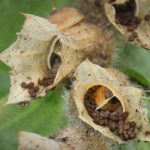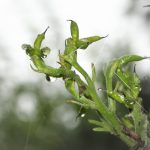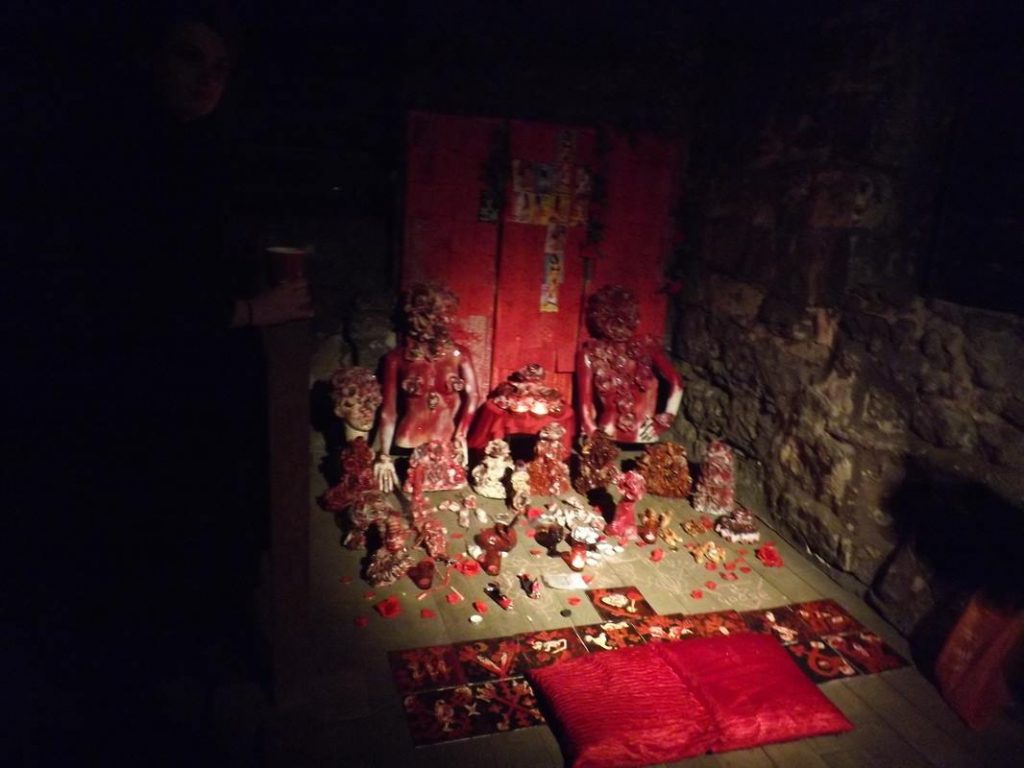 In my part of the world the past new moon occured close to the midnight hour and when the moon was just entering into the sign of Scorpio. In addition friends and followers in Eastern Asia and most of North America could simultaneously witness a beautiful partial solar eclipse. An astrologically and magically interesting time, some would already hold their Samhain celebrations on this night, closing another circle, saying farewell to the old and inaugurating a new year. It is the beginning of a liminal time, when the veil between the world of the living and the other side thinnens. It is believed the souls of the deceased – both beloved or malign, familiar or nameless – come to visit and contact the living, in dream or even physically. Temperatures are dropping, you see your breath in the cold air. The trees are yet aflame in autumn colors but will soon turn barren. Winter is just around the corner.
In my part of the world the past new moon occured close to the midnight hour and when the moon was just entering into the sign of Scorpio. In addition friends and followers in Eastern Asia and most of North America could simultaneously witness a beautiful partial solar eclipse. An astrologically and magically interesting time, some would already hold their Samhain celebrations on this night, closing another circle, saying farewell to the old and inaugurating a new year. It is the beginning of a liminal time, when the veil between the world of the living and the other side thinnens. It is believed the souls of the deceased – both beloved or malign, familiar or nameless – come to visit and contact the living, in dream or even physically. Temperatures are dropping, you see your breath in the cold air. The trees are yet aflame in autumn colors but will soon turn barren. Winter is just around the corner.
I felt it sooner this year than usual, perhaps owed to the early arrival of summer, autumn and winter are coming earlier as well. And it feels like its going to be a cold one. I experienced some dark days and nights, where I turned inside and contemplated, what has been done and what can and will be done. I got inspired and wrote these lines:
Autumn Fire
I feel the change of season
this autumn fire
the nights getting longer
the impending darkness
this cold breath down my neck.But I am aflame and
burning with passsion
to a degree that it
almost consumes me.Memories and dreams
the future and the past
they are merging
in a round-dance of autumn leaves
in the yellow light of street lamps
or in the dim grayness of
one drizzly September day.I am day dreaming
and the world around me becomes
like the surface of a pond
into which I dip my finger
and suddenly the whole picture
starts to ripple and disperse
and the voices of people talking to me are muted
and I hear something else.Silence.
The veil is thinning.
I am dreaming of reconciliation.
I hear from a lot of people this year has been their worst by far. Some say they felt a strong negative Saturn influence in their life. Things being stolen or lost, relationships breaking apart, unexpected changes for the worse and in some instances also suicide attempts. There was a lot happening around me and for all I know there is little in life to rely on. Believes and faith, relationships and worldly values are questioned and challenged. And the idea that from loss and pain still something good or even better arises, may infact not always hold true. Yet the quality of conversations improves, deepens. Superficialties don’t suffice any longer. And I still feel lucky. I do have my self, my work, and spirits and friends to turn to. Even if they may be struggeling themsselves; as long as there is a shared will to continue and work towards better times – not sit and wait – there is reason for hope.
What really helps me during times, when there is apparently nothing positive at all, is the feedback I receive from you, my customers and followers. It does indeed mean a great deal to me. It is one reason why I’m doing what I’m doing and why I continue this project. Feedback such as this:
Having received one of your plant sigil card sets, I wanted to thank you for your work and express my gratitude in having received one. It is a beautifully crafted work, with an obvious spine of honesty, experience and exploration. A profound expression of the green, from the veils of the divine. – JR/O.
Thank you and all who write me messages, comment, like and fave! Thanks to over 2000 followers on facebook and 500 on tumblr, thanks to my watchers on deviantArt and elsewhere! Thanks to the loud and silent supporters and the imps and gnomes and wizzards doing ‘magic’ in the background and spreading the word! You know who you are.
And though it is true that this is often a lonely path we do take inspiration from another, consciously or unconsciously. I like to think that the same spirits contact us individually and sometimes they whisper the same and other times different things into our ears. Tuesday I thought about harvesting Belladonna under the waning moon. But the night was cold and rainy and there was no sharp shining crescent sickle to be seen that would have called for harvest. Thursday I read of Harold Roth‘s plan to harvest Belladonna under the new moon. I first thought no, lets leave them for another month or wait for next year’s Walpurgis. But then I gave it a second thought, went outside short before midnight and the conditions were just right.
 The midnight hour was the hour of Venus and the dark moon had just entered Scorpio. A fitting constellation for working with the poisonous (scorpio) green (venus), and the darker aspects of the goddess (black moon), of whom the Belladonna is evocative. The Deadly Nightshade also has connections to the Germanic myths of the Wild Hunt, especially the Valkyries, daughters of heaven and earth (Wotan and Erda), who accompany the souls of the warriors that died in battle, to their final destination in Valhalla, which is reflected in the German name “Walkerbeere”. The Wild Hunt is said to begin with Samhain and culminates during the Winter Solstice and following nights. My first abstract vision of the plant’s essence shows her infront of a dark stormy sky with flashes of lightning and blood is raining from black clouds.
The midnight hour was the hour of Venus and the dark moon had just entered Scorpio. A fitting constellation for working with the poisonous (scorpio) green (venus), and the darker aspects of the goddess (black moon), of whom the Belladonna is evocative. The Deadly Nightshade also has connections to the Germanic myths of the Wild Hunt, especially the Valkyries, daughters of heaven and earth (Wotan and Erda), who accompany the souls of the warriors that died in battle, to their final destination in Valhalla, which is reflected in the German name “Walkerbeere”. The Wild Hunt is said to begin with Samhain and culminates during the Winter Solstice and following nights. My first abstract vision of the plant’s essence shows her infront of a dark stormy sky with flashes of lightning and blood is raining from black clouds.
I took two roots, grown in pots, and both about 3 years old. The plants have flowered ready and the lasts berries are also ripe. In fact the stems are already slowly dying back and new green sprouts come from the root base. So it was indeed good timing. Especially since the following nights were even colder and the green parts don’t survive freezing. It makes sense that the time around Samhain is traditionally the time for the last harvest, which is then put up in the home for drying.
I also encountered a surprise when digging up the second plant as it had grown a long tap-root. It wouldn’t take an end and I actually could not unearth it wholly. I had to dig much deeper to get to the end of the part still stuck in the ground and it turned out that entire thing was indeed over 40 cm long!
I removed the soil manually, then cleaned them in rainwater and put them on the harvest altar, together with previously harvested roots. I lit beeswax candles and offered libation. I noticed a spicy smell and, though I used gloves, felt actually a bit benumbed from the fumes. I learned that the alkaloids concentrate in the root during autumn and winter. It may well be possible these two roots have a higher potency. They are now drying slowly and I plan to later make fetishes with them that tie together visullay the mentioned astrological and magical aspects. Below are a few pictures to show you their raw beauty:
In September I had already gathered leaves and sprigs, which I put between newspaper pages for drying. What do you read in there? It’s been a Belladonna year for sure!
 Yet there are plenty of other herbs (and for that matter also seeds!) and so I find myself again running around the house and garden, collecting, sorting and processing all sorts of green harvest. It will still be a giant task to take photos of everything and make it available for ordering. I am also working on a larger herbal commissions, which includes labeling and filling custom bottles for a client.
Yet there are plenty of other herbs (and for that matter also seeds!) and so I find myself again running around the house and garden, collecting, sorting and processing all sorts of green harvest. It will still be a giant task to take photos of everything and make it available for ordering. I am also working on a larger herbal commissions, which includes labeling and filling custom bottles for a client.
At least I am ready now with rearranging our front garden (more about this later) and next is the raised bed. So lots to do this week until the official Samhain date. And I still have a very special interview in the making, as well as news concerning my contributions to the third Pillars Periodical Journal! But all in good time. 🙂
 So long, after so much deadly nightshade here is now another plant, which embodies the month of October: the Chinese Aconite (Aconitum carmichaelii), or Herbst-Eisenhut, as it is called in German, is the last of the aconites to flower and brightens up the October month with its lush blue-violett inflorescences. It’s poisonous as hell too and another name for aconite was in fact Scorpio. The aconite, as the ‘king of poisons’ is in different ways to be seen as a counterpart to the belladonna or ‘queen of poisons’, who’s atropine is the physiological antidote in aconite poisoning. Now I certainly wouldn’t recommend doing the test. However I do like to grow them besides each other, for higher inspiration and guidance. In fact, I do have quite a few aconite and belladonna seedlings to plant out yet… Yep, lots do! 🙂
So long, after so much deadly nightshade here is now another plant, which embodies the month of October: the Chinese Aconite (Aconitum carmichaelii), or Herbst-Eisenhut, as it is called in German, is the last of the aconites to flower and brightens up the October month with its lush blue-violett inflorescences. It’s poisonous as hell too and another name for aconite was in fact Scorpio. The aconite, as the ‘king of poisons’ is in different ways to be seen as a counterpart to the belladonna or ‘queen of poisons’, who’s atropine is the physiological antidote in aconite poisoning. Now I certainly wouldn’t recommend doing the test. However I do like to grow them besides each other, for higher inspiration and guidance. In fact, I do have quite a few aconite and belladonna seedlings to plant out yet… Yep, lots do! 🙂
October 26, 2014
Posted In: Herbs & Seeds, Garden, Art, Feast Days, Ritual
Tags: ritual, moon in scorpio, aconite, new moon, poisonous plants, october, roots, saturn, belladonna, saturnian, samhain, autumn Fire, black moon, harvest, herbs, helloween



































 There is another herb currently flowering and bringing me much joy. And this herb shall introduce the stroll through the venific garden. The herb I am talking about is the White Henbane (Hyoscyamus albus). Sometimes it is also referred to as Yellow Henbane. This herb is a
There is another herb currently flowering and bringing me much joy. And this herb shall introduce the stroll through the venific garden. The herb I am talking about is the White Henbane (Hyoscyamus albus). Sometimes it is also referred to as Yellow Henbane. This herb is a  The stamina are coming more out of the bell-shaped flower chalices and are a pale yellow
The stamina are coming more out of the bell-shaped flower chalices and are a pale yellow The White Henbane is native to the Mediterraneans and likes hot and dry climates. I actually think to have seen it growing wild by the sea when visiting Malta! Hence I guess last year was simply too rainy and cold for the plantlets. This year I could sow earlier and the temperatures have been relatively warm and stable. Anyway, I have not worked with the plant further than growing it. I imagine thought it will make a fine addition to white powders and incense for divination and necromancy – possibly also for restoring lost memories. And it makes me think of summer, sun and the sea! All this in mind I am starting to wonder whether this is not the actual herba apollinaris, which was part of divinatory incense offered up to the oracle at Delphi…
The White Henbane is native to the Mediterraneans and likes hot and dry climates. I actually think to have seen it growing wild by the sea when visiting Malta! Hence I guess last year was simply too rainy and cold for the plantlets. This year I could sow earlier and the temperatures have been relatively warm and stable. Anyway, I have not worked with the plant further than growing it. I imagine thought it will make a fine addition to white powders and incense for divination and necromancy – possibly also for restoring lost memories. And it makes me think of summer, sun and the sea! All this in mind I am starting to wonder whether this is not the actual herba apollinaris, which was part of divinatory incense offered up to the oracle at Delphi… You see the flowers are also slightly larger and of course the purple veins spread all across the yellow petals!
You see the flowers are also slightly larger and of course the purple veins spread all across the yellow petals!  And remember the story about Python slain by Apollo? Its body fell into a crevice in the ground and from the decomposing corpse intoxicating vapors rose up. Above that mythical place the oracle of Delphi was built and the priestess (Pythia), inhaling the fumes, became possessed by Apollo to foretell the future. It all leads again to that oracle… perhaps it’s time to offer some Delphian oracle incense? But least we forget, Henbane was also part of Pillars
And remember the story about Python slain by Apollo? Its body fell into a crevice in the ground and from the decomposing corpse intoxicating vapors rose up. Above that mythical place the oracle of Delphi was built and the priestess (Pythia), inhaling the fumes, became possessed by Apollo to foretell the future. It all leads again to that oracle… perhaps it’s time to offer some Delphian oracle incense? But least we forget, Henbane was also part of Pillars 






















